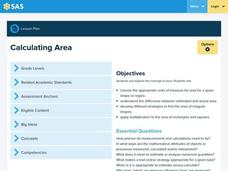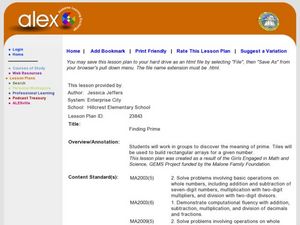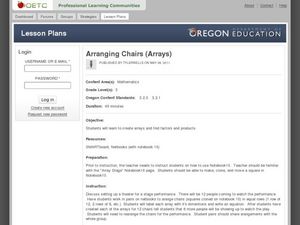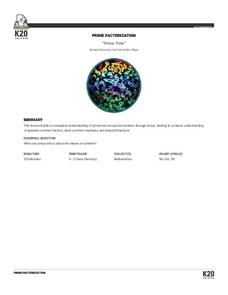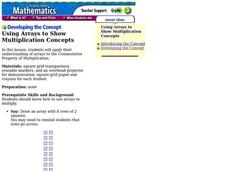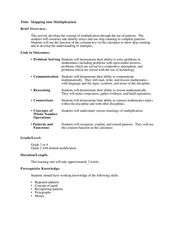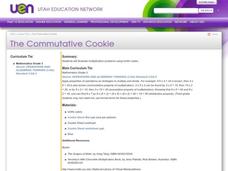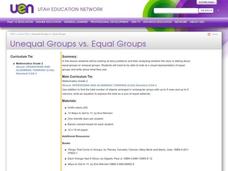Pennsylvania Department of Education
Multiplication Using Arrays
Explore the concept of multiplication by using arrays. Classmates use arrays to gain a better understanding of multiplication. They break arrays apart to model the distributive property of multiplication over addition. The relationship...
Alabama Learning Exchange
Finding Prime
Fifth and sixth graders explore prime numbers. They work with a partner to build rectangular arrays using twelve tiles. Factor pairs are noted and recorded on graph paper. Pupils construct rectangular arrays with a prime number and...
Curated OER
Arranging Chairs (Arrays)
The creation of arrays is the focus of this mathematics lesson. Pupils consider a situation for a theater stage performance: different amounts of people are coming to the show, and they must arrange the seats in rows of equal numbers. A...
K20 LEARN
Prime Time
How many prime numbers are there between 1 and 100? By using a prime time resource, your scholars should be able to answer this question. Using arrays, they determine if numbers are prime or composite, and then write a prime...
Teach Engineering
Maximum Power Point
Investigate the maximum power output of a photovoltaic panel with a instructional activity that introduces the class to the maximum power point. Individuals learn how to determine the maximum power point of a solar panel by using Ohm's...
Alabama Learning Exchange
Miss Integer Finds Her Properties in Order
Access prior knowledge to practice concepts like order of operations and exponents. Your class can play this game as a daily review or as a warm-up activity when needed. They work in groups of four to complete and correct review problems.
Curated OER
Using Arrays to Show Multiplication Concepts
Students draw arrays. In this multiplication lesson, students draw arrays, write multiplication sentences for arrays and discuss how changing the order of the factors affects the product.
Curated OER
Prime and Composite Numbers
Fifth graders use prime factorization to identify prime and composite numbers. They use cubes to find factors. In groups, 5th graders draw rectangular arrays to discover prime numbers under 100.
Curated OER
Study Buddies: Fact Families
Second and third graders work with a coach to find multiplication and division fact families. They follow a step-by-step process and notes are provided for the coach.
Curated OER
Relating Multiplication and Division
Help the class determine missing factors in equations by creating arrays. Through modeling and practice, they come to see the inverse relationship between multiplication and division. As an assessment, individuals build their own array...
Curated OER
Arrays And Factors
Students participate in a lesson that is concerned with the concepts of arrays and factors. They use a Hershey bar and divide it into segments in order to simulate the arrays. Then students construct other arrays from the leftover pieces.
Curated OER
Prime Numbers and Factors
Students determine factors of numbers to 100 and identify prime factors; students differentiate prime and composite numbers by the factors of the numbers.
Curated OER
Making Arrays
In this making arrays worksheet, students, working with a partner, study and calculate how to make arrays by completing six exercises.
Curated OER
Multiplying Decimals
In this mathematics worksheet, 6th graders estimate the product and use an array to help them find the product. Then they find the exact product and locate where to put the decimal point in each.
Curated OER
Multiplying by Two-Digit Numbers
In this mathematics worksheet, 6th graders find the product of a given equation. Then they use an array and find the sum of the partial products. Students also use zeros as place holders when necessary.
Curated OER
Skipping Into Multiplication
Young mathematicians study the relationship between skip counting and multiplication. They build on skip counting skills and examine arrays while studying multiplication. Resources are provided.
Curated OER
Disappearing Magic Factors
Students identify, through the number of rows and columns, the factors related to the product. In turn, they also discover how to find the missing factor, which is part of the fact family for that product.
Pennsylvania Department of Education
Volume of Compound Figures
Fifth graders use patterns, models and relationships to solve equations. In this equations lesson plan, 5th graders define vocabulary for equations and complete worksheets explaining variables and solving problems.
Curated OER
The Commutative Cookie
Third graders investigate the commutative properties of multiplication and focus upon the setting of cubes in the correct patterns to solve problems. They differentiate between numbers that have multiple factors and prime numbers....
Curated OER
Unequal Groups vs. Equal Groups
Third graders read and discuss math story problems and analyze if the story is using equal groups or unequal groups. They listen to the book "12 Ways To Get to 11," and simulate the story using beads on a pipe cleaner. Students then...
Curated OER
Relating Multiplication and Division
Students use counters to review arrays and multiplication and learn arrays and division. In this multiplication and division lesson, students use counters to arrange multiplication equations and division equations.
Curated OER
Multiplying Three Numbers
In this multiplying three numbers worksheet, learners, working with a partner, problem solve and calculate the answers to eighteen word problems or mathematical equations involving multiplication.
Curated OER
Number in Geometry
Learners use a number line to assist with their additions. They use a calculator to check for factors. Students are taught factors and multiples. They use array model of multiplication to define meaning. Learners develop a wide range of...
Curated OER
Multiplication Lesson
Fourth graders use grid paper, M&M's, and vocabulary words, to correctly complete multiplication problems. In this multiplication lesson plan, 4th graders complete number sentences, use symbols, solve equations, and more.
